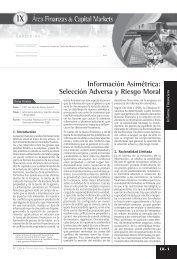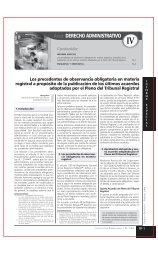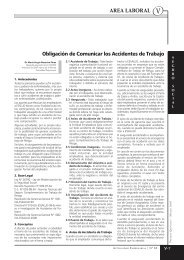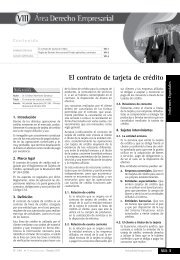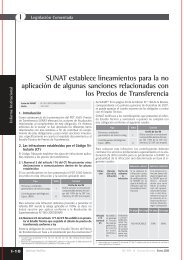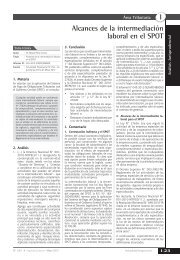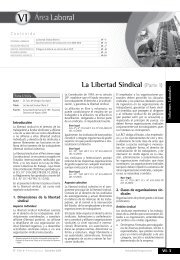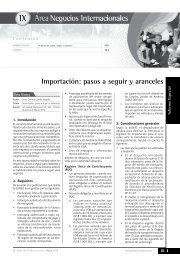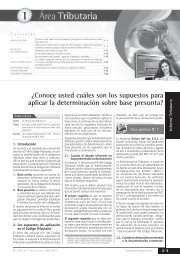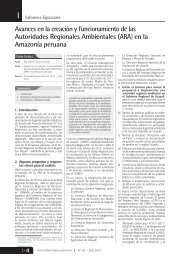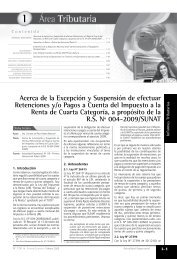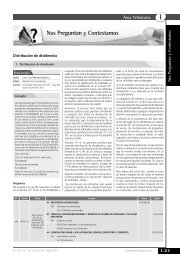IV El flujo de caja como herramienta financiera - Revista Actualidad ...
IV El flujo de caja como herramienta financiera - Revista Actualidad ...
IV El flujo de caja como herramienta financiera - Revista Actualidad ...
You also want an ePaper? Increase the reach of your titles
YUMPU automatically turns print PDFs into web optimized ePapers that Google loves.
Ficha Técnica<br />
N° 277 Segunda Quincena - Abril 2013<br />
Área Contabilidad (NIIF) y Costos<br />
<strong>El</strong> <strong>flujo</strong> <strong>de</strong> <strong>caja</strong> <strong>como</strong> <strong>herramienta</strong> <strong>financiera</strong><br />
Autora : C.P.C. Luz Hirache Flores<br />
Título : <strong>El</strong> <strong>flujo</strong> <strong>de</strong> <strong>caja</strong> <strong>como</strong> <strong>herramienta</strong> <strong>financiera</strong><br />
Fuente : <strong>Actualidad</strong> Empresarial Nº 277 - Segunda<br />
Quincena <strong>de</strong> Abril 2013<br />
1. Introducción<br />
<strong>El</strong> <strong>flujo</strong> <strong>de</strong> <strong>caja</strong> es una <strong>herramienta</strong> <strong>financiera</strong><br />
muy utilizada por las empresas, tiene<br />
la finalidad <strong>de</strong> i<strong>de</strong>ntificar la capacidad <strong>de</strong><br />
la empresa <strong>de</strong> contar con disponibilidad<br />
o <strong>de</strong>ficiencia <strong>de</strong> efectivo.<br />
Su elaboración implicará que la entidad<br />
realice pronósticos sobre hechos futuros<br />
que se esperan lograr sobre la base <strong>de</strong><br />
un plan <strong>de</strong> negocios. Hay que tener en<br />
consi<strong>de</strong>ración que cuando elaboramos un<br />
<strong>flujo</strong> <strong>de</strong> <strong>caja</strong>, <strong>de</strong>bemos <strong>de</strong> i<strong>de</strong>ntificar el<br />
<strong>flujo</strong> <strong>de</strong> efectivo operativo que se produce<br />
o producirán por las operaciones propias<br />
<strong>de</strong>l giro <strong>de</strong>l negocio. A continuación proporcionamos<br />
mayor <strong>de</strong>talle y casuística.<br />
2. Flujo <strong>de</strong> <strong>caja</strong><br />
También conocido <strong>como</strong> “cash flow”,<br />
muestra el saldo <strong>de</strong> los ingresos menos<br />
los egresos <strong>de</strong> efectivo (en términos<br />
nominales <strong>de</strong>l efectivo) <strong>de</strong> una empresa,<br />
generados por una inversión, actividad<br />
productiva o proyecto, en un periodo<br />
<strong>de</strong>terminado. Es posible también elaborar<br />
un <strong>flujo</strong> <strong>de</strong> <strong>caja</strong> proyectado, conocido<br />
también <strong>como</strong> “presupuesto <strong>de</strong> <strong>caja</strong>” o<br />
“pronóstico <strong>de</strong> tesorería”.<br />
Su elaboración está a cargo <strong>de</strong> tesorería<br />
o la que haga sus veces, la que reporta<br />
a la gerencia <strong>financiera</strong> <strong>de</strong> la empresa,<br />
pue<strong>de</strong> realizarse <strong>de</strong> manera mensual,<br />
bimestral, semestral, anual, etc.; sin embargo,<br />
mientras más corto sea el periodo<br />
<strong>de</strong> evaluación, los resultados obtenidos<br />
serán más precisos.<br />
2.1. Importancia y objetivo <strong>de</strong>l <strong>flujo</strong><br />
<strong>de</strong> <strong>caja</strong><br />
La importancia y objetivo <strong>de</strong>l <strong>flujo</strong> <strong>de</strong> <strong>caja</strong><br />
radican en que:<br />
- Permiten conocer la liqui<strong>de</strong>z <strong>de</strong> la<br />
empresa y controlar el movimiento<br />
<strong>de</strong>l efectivo para un periodo <strong>de</strong>terminado.<br />
- Permiten establecer el nivel mínimo<br />
<strong>de</strong> efectivo, para i<strong>de</strong>ntificar los periodos<br />
<strong>de</strong> déficit o exce<strong>de</strong>nte <strong>de</strong> efectivo.<br />
- Permiten i<strong>de</strong>ntificar la necesidad mínima<br />
<strong>de</strong> efectivo, para fijar políticas<br />
<strong>de</strong> financiamiento (<strong>como</strong> ajustar el<br />
periodo <strong>de</strong> condiciones crediticias).<br />
- Permiten la a<strong>de</strong>cuada toma <strong>de</strong> <strong>de</strong>cisiones<br />
sobre el uso y <strong>de</strong>stino <strong>de</strong>l efectivo y<br />
equivalente <strong>de</strong> efectivo (nuevas inversiones,<br />
segmentos operativos, etc.).<br />
<strong>El</strong> <strong>flujo</strong> <strong>de</strong> <strong>caja</strong> es una <strong>herramienta</strong> <strong>financiera</strong><br />
que permite valuar la empresa aplicando<br />
el método <strong>de</strong> <strong>flujo</strong>s <strong>de</strong>scontados,<br />
i<strong>de</strong>ntificando fuentes <strong>de</strong> valor agregado<br />
Ingresos<br />
Ventas al contado<br />
Cobranzas <strong>de</strong> ventas al crédito<br />
Enajenación <strong>de</strong> activos inmovilizados<br />
Préstamos <strong>de</strong> accionistas<br />
Préstamos <strong>de</strong> instituciones <strong>financiera</strong>s<br />
u otras entida<strong>de</strong>s<br />
2.3. Clases <strong>de</strong> <strong>flujo</strong> <strong>de</strong> <strong>caja</strong><br />
Existen dos clases <strong>de</strong> <strong>flujo</strong> <strong>de</strong> <strong>caja</strong> y son:<br />
a. Flujo <strong>de</strong> <strong>caja</strong> operativo o económico:<br />
Conformado por los ingresos y egresos<br />
propios <strong>de</strong> la actividad económica <strong>de</strong><br />
la empresa, neto <strong>de</strong> los impuestos.<br />
Flujo <strong>de</strong> <strong>caja</strong><br />
económico<br />
b. Flujo <strong>de</strong> <strong>caja</strong> financiero y para los<br />
accionistas: Este recaba los <strong>flujo</strong>s <strong>de</strong><br />
capitales <strong>de</strong> inversiones y financiamiento<br />
requeridos por la empresa,<br />
sin <strong>de</strong>scontar impuestos.<br />
Activida<strong>de</strong>s <strong>de</strong><br />
operación<br />
Activida<strong>de</strong>s <strong>de</strong><br />
inversión<br />
<strong>Actualidad</strong> Empresarial<br />
<strong>IV</strong><br />
y apalancamiento; permite evaluar el<br />
nivel <strong>de</strong> rentabilidad actual en función<br />
<strong>de</strong>l valor <strong>de</strong> la empresa, obtener fuentes<br />
<strong>de</strong> financiamiento (nuevos inversionistas<br />
o socios estratégicos), evaluar alianzas<br />
estratégicas sobre proyectos a empren<strong>de</strong>r.<br />
2.2. Estructura <strong>de</strong>l <strong>flujo</strong> <strong>de</strong> <strong>caja</strong><br />
Egresos<br />
Pago <strong>de</strong> remuneraciones y beneficios<br />
sociales a los trabajadores<br />
Pago a terceros por servicios prestados<br />
Pago <strong>de</strong> impuestos<br />
Desembolso <strong>de</strong> otros costos fijos<br />
Adquisición <strong>de</strong> activos inmovilizados<br />
Amortización <strong>de</strong> préstamos <strong>de</strong> accionistas<br />
Amortización <strong>de</strong> préstamos bancarios<br />
Es aquel <strong>flujo</strong> que no incluye en su cálculo<br />
los ingresos y egresos <strong>de</strong> efectivo<br />
vinculados al financiamiento, ni <strong>de</strong>udas<br />
con terceros. Bajo este criterio, se presume<br />
que la empresa se solventa económicamente<br />
con sus recursos propios (<strong>flujo</strong>s<br />
operativos).<br />
Ingresos<br />
Egresos<br />
Capital <strong>de</strong> trabajo<br />
Inversiones<br />
Valor <strong>de</strong> recupero<br />
En contraste con el <strong>flujo</strong> <strong>de</strong> <strong>caja</strong> operativo,<br />
incluyendo los ingresos y egresos vinculados<br />
al financiamiento por terceros o accionistas,<br />
mostrando la liqui<strong>de</strong>z <strong>de</strong> las activida<strong>de</strong>s <strong>de</strong><br />
la empresa en un periodo <strong>de</strong> tiempo.<br />
Aplicación Práctica<br />
<strong>IV</strong>-5
<strong>IV</strong><br />
Flujo <strong>de</strong> Caja<br />
Financiero<br />
La elaboración <strong>de</strong> la proyección <strong>de</strong>l <strong>flujo</strong><br />
financiero implicará contar con la siguiente<br />
información:<br />
• I<strong>de</strong>ntificar la necesidad <strong>de</strong> financiación<br />
<strong>de</strong> la empresa.<br />
• Evaluar las condiciones actuales <strong>de</strong>l<br />
mercado financiero y/o <strong>de</strong> capitales.<br />
• Perspectivas sobre el acceso a mercados<br />
financieros y <strong>de</strong> capitales en el<br />
futuro por parte <strong>de</strong> la empresa.<br />
• Expectativas sobre el comportamiento<br />
<strong>de</strong> las tasas <strong>de</strong> interés, <strong>de</strong>valuación e<br />
inflación.<br />
• Disponibilidad <strong>de</strong> los socios para<br />
capitalizar.<br />
• Soli<strong>de</strong>z óptima.<br />
Después <strong>de</strong> haber consi<strong>de</strong>rado el pago<br />
<strong>de</strong>l servicio <strong>de</strong> la <strong>de</strong>uda <strong>financiera</strong> los<br />
nuevos recursos <strong>de</strong> <strong>de</strong>uda, los aportes<br />
<strong>de</strong> capital <strong>de</strong> los socios y los ingresos no<br />
operacionales, se obtiene el <strong>flujo</strong> <strong>de</strong> <strong>caja</strong><br />
disponible para accionistas.<br />
Son estos <strong>flujo</strong>s los que se utilizan para<br />
remunerar la inversión <strong>de</strong> los accionistas,<br />
(pago <strong>de</strong> divi<strong>de</strong>ndos y/o exce<strong>de</strong>ntes <strong>de</strong><br />
liqui<strong>de</strong>z).<br />
Flujo <strong>de</strong> Caja<br />
Operativo<br />
Flujo <strong>de</strong> Caja<br />
Financiero<br />
Flujo <strong>de</strong> Caja<br />
Accionistas<br />
Aplicación Práctica<br />
Presupuesto <strong>de</strong><br />
<strong>caja</strong> económico o<br />
operativo<br />
Presupuesto <strong>de</strong><br />
<strong>caja</strong> financiero<br />
neto<br />
EBITDA<br />
+/- Capital <strong>de</strong> trabajo<br />
- Inversiones<br />
- Impuestos<br />
FlUJo DE CAJA lIBrE<br />
+ Desembolsos <strong>de</strong> <strong>de</strong>uda<br />
- Gastos financieros<br />
- Amortización <strong>de</strong> préstamos<br />
+ Aportes <strong>de</strong> capital<br />
+ Ingresos no operacionales<br />
= FlUJo DE CAJA FInAn-<br />
CIEro<br />
+ Caja inicial<br />
= FlUJo DE CAJA DISPonIBlE<br />
PArA SoCIoS<br />
- Divi<strong>de</strong>ndos<br />
- Exce<strong>de</strong>ntes <strong>de</strong> liqui<strong>de</strong>z<br />
= CAJA FInAl<br />
Activida<strong>de</strong>s <strong>de</strong><br />
operación<br />
Activida<strong>de</strong>s <strong>de</strong><br />
inversión<br />
Activida<strong>de</strong>s <strong>de</strong><br />
financiamiento<br />
2.4. Métodos para elaborar <strong>flujo</strong> <strong>de</strong><br />
<strong>caja</strong><br />
Muchas empresas obtienen utilida<strong>de</strong>s<br />
al cierre <strong>de</strong>l ejercicio, sin embargo dicho<br />
resultado no se refleja en la misma<br />
cuantía en la partida <strong>de</strong> efectivo (<strong>caja</strong>);<br />
actualmente la empresas no cuentan con<br />
efectivo para afrontar sus obligaciones<br />
operativas y <strong>financiera</strong>s, a pesar <strong>de</strong> haber<br />
obtenido utilida<strong>de</strong>s.<br />
Esto se produce <strong>de</strong>bido a la base <strong>de</strong><br />
reconocimiento y preparación <strong>de</strong> la<br />
información <strong>financiera</strong>, obteniéndose el<br />
resultado <strong>de</strong>l ejercicio en la oportunidad<br />
<strong>de</strong>l <strong>de</strong>vengo, la empresa pue<strong>de</strong> elaborar<br />
reportes financieros <strong>de</strong>sarrollados sobre<br />
la base <strong>de</strong>l percibido, a este reporte se<br />
le <strong>de</strong>nomina FLUJO DE CAJA, y para ello<br />
po<strong>de</strong>mos utilizar los siguientes métodos:<br />
a) Método <strong>de</strong> entradas y salidas<br />
<strong>de</strong> efectivo: Se <strong>de</strong>be i<strong>de</strong>ntificar las<br />
entradas <strong>de</strong> efectivo y las salidas <strong>de</strong><br />
efectivo generadas por las activida<strong>de</strong>s<br />
operacionales <strong>de</strong> la empresa y<br />
aquellas no operacionales. Esta i<strong>de</strong>ntificación<br />
nos permite <strong>de</strong>tectar si el<br />
incremento o <strong>de</strong>sarrollo <strong>de</strong> la liqui<strong>de</strong>z<br />
son financiados por recursos propios<br />
o extraordinarios.<br />
b) Método <strong>de</strong>l estado <strong>de</strong> situación <strong>financiera</strong><br />
proyectado: <strong>El</strong> <strong>flujo</strong> <strong>de</strong> <strong>caja</strong><br />
se elabora sobre la comparación entre<br />
un estado <strong>de</strong> situación <strong>financiera</strong> <strong>de</strong>l<br />
año actual y otro pronosticado para<br />
el periodo siguiente.<br />
c) Método <strong>de</strong>l estado <strong>de</strong> resultados<br />
proyectado: Consiste en <strong>de</strong>terminar<br />
el <strong>flujo</strong> <strong>de</strong> <strong>caja</strong> respecto <strong>de</strong> un estado<br />
<strong>de</strong> resultados estimado, agregando<br />
b) <strong>El</strong> área <strong>de</strong> ventas ha elaborado el<br />
siguiente presupuesto <strong>de</strong> ventas, <strong>de</strong>l<br />
primer semestre <strong>de</strong>l 2013:<br />
Enero 910,000<br />
Febrero 950,000<br />
Marzo 980,000<br />
Abril 970,000<br />
Mayo 990,000<br />
Junio 980,000<br />
c) Las condiciones <strong>de</strong> venta son: 70 %<br />
contado, 20 % crédito a 30 días y<br />
10 % crédito a 60 días.<br />
d) Para la elaboración <strong>de</strong>l <strong>flujo</strong> <strong>de</strong><br />
<strong>caja</strong> se solicita al área <strong>de</strong> logística<br />
el programa <strong>de</strong> adquisiciones <strong>de</strong><br />
merca<strong>de</strong>rías y se obtiene la siguiente<br />
información:<br />
- Las compras generalmente representan<br />
el 60 % <strong>de</strong> las ventas<br />
mensuales<br />
- La condiciones <strong>de</strong> pago a los<br />
proveedores es el 70 % a 30 % y<br />
el 30 % a 90 días<br />
e) Otros datos:<br />
1. Costos laborales mensuales durante<br />
el primer semestre <strong>de</strong>l 2013:<br />
Descripción Ene. Feb. Mar. Abr. May. Jun.<br />
Planilla por pagar (neto dsctos.) 70,000 90,000 92,000 72,000 98,000 96,000<br />
Essalud (9 %) 7,241.00 9,310.00 9,517.00 7,448.00 10,138.00 9,931.00<br />
ONP (13 %) 10,460.00 13,448.00 13,747.00 10,759.00 14,644.00 14,345.00<br />
*En enero se paga Essalud y ONP <strong>de</strong>l mes <strong>de</strong> diciembre 2012, ascen<strong>de</strong>nte a S/.24,700.<br />
<strong>IV</strong>-6 Instituto Pacífico N° 277 Segunda Quincena - Abril 2013<br />
Ingresos<br />
Egresos<br />
Capital <strong>de</strong> trabajo<br />
Inversiones<br />
Valor <strong>de</strong> recupero<br />
Ingreso <strong>de</strong> préstamos<br />
Amortización <strong>de</strong> préstamos<br />
Intereses<br />
o disminuyendo a la utilidad aquellas<br />
partidas que afecten la <strong>caja</strong> y<br />
que se traten <strong>de</strong> ventas o gastos,<br />
tales <strong>como</strong> <strong>de</strong>preciación, amortización,<br />
las inversiones en activo fijo o<br />
en capital <strong>de</strong> trabajo, divi<strong>de</strong>ndos,<br />
préstamos y aportes <strong>de</strong> capital, entre<br />
otros.<br />
<strong>El</strong> método más utilizado es el <strong>de</strong> entradas<br />
y salidas <strong>de</strong> efectivo; los otros dos implican<br />
la elaboración <strong>de</strong> estados financieros<br />
proyectados.<br />
3. Casuística<br />
La distribuidora Dora S.A.C., se <strong>de</strong>dica<br />
a la comercialización <strong>de</strong> plásticos al por<br />
mayor y menor.<br />
a) Durante los tres últimos meses <strong>de</strong>l<br />
2012, ha realizado las siguientes<br />
ventas:<br />
Octubre 980,000<br />
Noviembre 890,000<br />
Diciembre 1,600,000
2. Alquiler <strong>de</strong>l local ascien<strong>de</strong> a S/.1,000 mensuales según<br />
contrato por un año.<br />
3. En marzo se espera <strong>de</strong>sarrollar gastos por publicidad por<br />
S/.1,950.<br />
4. En el mes <strong>de</strong> junio se amortizará un préstamo adquirido en<br />
el 2012, por S/.110,000 más intereses por S/.25,000.<br />
5. <strong>El</strong> pago acuenta se realizará aplicando la tasa <strong>de</strong>l 1.5 %<br />
sobre las ventas mensuales (según las normas tributarias).<br />
Descripción Dic.-12 Ene. Feb. Mar. Abr. May. Jun.<br />
Ventas mensuales<br />
1,600,000 910,000 950,000 980,000 970,000 990,000 980,000<br />
Pago a cuenta<br />
IR (1.5 %) 24,000.00 13,650.00 14,250.00 14,700.00 14,550.00 14,850.00 14,700.00<br />
6. <strong>El</strong> saldo <strong>de</strong> <strong>caja</strong> al 01.01.13 es <strong>de</strong> S/.7,000, y se <strong>de</strong>sea<br />
mantener un saldo mínimo mensual <strong>de</strong> <strong>caja</strong> <strong>de</strong> S/.1,200.<br />
7. Podrán acce<strong>de</strong>r a créditos bancarios <strong>de</strong> ser necesarios,los cuales<br />
serán cancelados en el primer semestre <strong>de</strong>l próximo año.<br />
8. En mayo se comprará un equipo <strong>de</strong> cómputo valorizada en<br />
S/.5,500, alcontado.<br />
9. En febrero se comprará un equipo <strong>de</strong> aire acondicionado,<br />
cuyo costo ascien<strong>de</strong> a 10,000, la cuota inicial a 4,000 y el<br />
saldo en dos cuotas <strong>de</strong> 3,000 en marzo y abril.<br />
Solución<br />
Paso1. <strong>El</strong>aborar los presupuestos correspondientes a las<br />
ventas, cobranza, compras y pagos a proveedores<br />
1. Presupuesto <strong>de</strong> ventas<br />
Condición <strong>de</strong><br />
cobranza<br />
Ene. Feb. Mar. Abr. May. Jun.<br />
Contado (70 %) 637,000 665,000 686,000 679,000 693,000 686,000<br />
Crédito 30d (20 %) 182,000 190,000 196,000 194,000 198,000 196,000<br />
Crédito 60d (10 %) 91,000 95,000 98,000 97,000 99,000 98,000<br />
Ventas Totales 910,000 950,000 980,000 970,000 990,000 980,000<br />
N° 277 Segunda Quincena - Abril 2013<br />
Área Contabilidad (NIIF) y Costos<br />
2. Presupuesto cobranzas<br />
<strong>Actualidad</strong> Empresarial<br />
<strong>IV</strong><br />
Condición <strong>de</strong><br />
cobranza<br />
Ene. Feb. Mar. Abr. May. Jun.<br />
Contado (70 %) 637,000 665,000 686,000 679,000 693,000 686,000<br />
Crédito 30 d (20 %) 320,000 182,000 190,000 196,000 194,000 198,000<br />
Crédito 60 d (10 %) 89,000 160,000 91,000 95,000 98,000 97,000<br />
Total 1,046,000 1,007,000 967,000 970,000 985,000 981,000<br />
3. Presupuesto <strong>de</strong> compras<br />
Condición <strong>de</strong><br />
pago<br />
Ene. Feb. Mar. Abr. May. Jun.<br />
Crédito 30 d (70 %) 382,200 399,000 411,600 407,400 415,800 411,600<br />
Crédito 90 d (30 %) 163,800 171,000 176,400 174,600 178,200 176,400<br />
Totales 546,000 570,000 588,000 582,000 594,000 588,000<br />
La cobranza en el 2013 por ventas <strong>de</strong>vengadas en el 2012 son:<br />
Condición <strong>de</strong> pago oct. nov. Dic.<br />
Crédito 30 d (70 %) 411,600 373,800 672,000<br />
Crédito 90 d (30 %) 176,400 160,200 288,000<br />
Totales 588,000 534,000 960,000<br />
4. Cuadro auxiliar <strong>de</strong> pagos a proveedores<br />
Mes Ene. Feb. Mar. Abr. May. Jun.<br />
Compras: oct.-12 176,400<br />
Compras: nov.-12 160,200<br />
Compras: dic.-12 672,000 288,000<br />
Compras: ene.-13 382,200 163,800<br />
Compras: feb.-13 399,000 171,000<br />
Compras: mar.-13 407,400 176,400<br />
Compras: abr.-13 407,400<br />
Compras: may.-13 415,800<br />
Pagos a proveedores 848,400 542,400 687,000 571,200 578,400 592,200<br />
Paso 2: I<strong>de</strong>ntificar los ingresos y egresos distinguiéndolos <strong>de</strong> aquellos producidos por el giro <strong>de</strong>l negocio (operacionales),<br />
<strong>de</strong> los no operacionales (inversión y financiamiento).<br />
5. Flujo <strong>de</strong> <strong>caja</strong> I semestre 2013<br />
resumen Ene. Feb. Mar. Abr. May. Jun. Total.<br />
Caja al 01.01.13 7,000.0<br />
Suma <strong>de</strong> cobros (entradas <strong>de</strong> efectivo) 1,046,000.0 1,007,000.0 967,000.0 970,000.0 985,000.0 981,000.0 5,956,000.0<br />
Suma <strong>de</strong> pagos (salidas <strong>de</strong> efectivo) (968,100.0) (668,751.0) (821,958.0) (685,164.0) (715,657.0) (863,832.0) (4,723,462.0)<br />
Caja mínima (1,200.0) (1,200.0) (1,200.0) (1,200.0) (1,200.0) (1,200.0) (7,200.0)<br />
Flujo <strong>de</strong> <strong>caja</strong> neto (cobros - pagos) 76,700.0 337,049.0 143,842.0 283,636.0 268,143.0 115,968.0 1,225,338.0<br />
Saldo <strong>de</strong> <strong>caja</strong> al final 83,700.0 420,749.0 564,591.0 848,227.0 1,116,370.0 1,232,338.0 1,232,338.0<br />
Flujos operativos 77,900.0 342,249.0 148,042.0 287,836.0 274,843.0 252,168.0 1,383,038.0<br />
Cobros por ventas al contado 637,000.0 665,000.0 686,000.0 679,000.0 693,000.0 686,000.0 4,046,000.0<br />
Cobros por ventas a crédito 409,000.0 342,000.0 281,000.0 291,000.0 292,000.0 295,000.0 1,910,000.0<br />
Pagos <strong>de</strong> planillas (70,000.0) (90,000.0) (92,000.0) (72,000.0) (98,000.0) (96,000.0) (518,000.0)<br />
Pagos <strong>de</strong> aportes y contribuciones (24,700.0) (17,701.0) (22,758.0) (23,264.0) (18,207.0) (24,782.0) (131,412.0)<br />
Pagos a proveedores (848,400.0) (542,400.0) (687,000.0) (571,200.0) (578,400.0) (592,200.0) (3,819,600.0)<br />
Pagos <strong>de</strong> arrendamientos (1,000.0) (1,000.0) (1,000.0) (1,000.0) (1,000.0) (1,000.0) (6,000.0)<br />
Pagos <strong>de</strong> servicios <strong>de</strong> publicidad (1,950.0) (1,950.0)<br />
Pagos <strong>de</strong> impuestos (24,000.0) (13,650.0) (14,250.0) (14,700.0) (14,550.0) (14,850.0) (96,000.0)<br />
Flujos <strong>de</strong> inversión 0.0 (4,000.0) (3,000.0) (3,000.0) (5,500.0) 0.0 (15,500.0)<br />
Pagos por compras <strong>de</strong> activo fijo (4,000.0) (3,000.0) (3,000.0) (5,500.0) (15,500.0)<br />
Cobros por ventas <strong>de</strong> activo fijo 0.0<br />
Flujos financieros 0.0 0.0 0.0 0.0 0.0 (135,000.0) (135,000.0)<br />
Pagos <strong>de</strong> intereses (25,000.0) (25,000.0)<br />
Pagos <strong>de</strong> préstamos bancarios (110,000.0) (110,000.0)<br />
Pagos <strong>de</strong> divi<strong>de</strong>ndos 0.0<br />
<strong>IV</strong>-7




